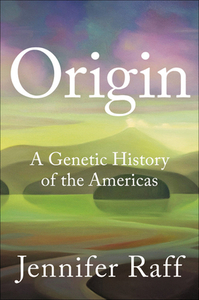Take a photo of a barcode or cover
adventurous
informative
medium-paced
SUMMARY: A fascinating overview of our current knowledge of the Peopling of the Americas based on scientific evidence from a number of disciplines along with illuminating discussions of where and why controversies still exist
When I was in grade school, I was taught that the Native Peoples of the Americas arrived in the New World after traipsing across the now-submerged Bering Land Bridge around ten thousand years ago, and that was the end of that story. I spent a lot of time contemplating what life might have been like for these intrepid explorers: the intense wind and cold, the towering glaciers, the lack of hand-warmers, the dearth of anything green to eat.
As I read further, I discovered that scientists barely knew more than what I was originally told about the Peopling of the Americas. But thanks to cutting-edge DNA technologies, the information we have now is rapidly growing. As you might imagine, this mystery is a topic of intense research and amazing discoveries. For example, we now think that anatomically modern humans arrived in the Americas at least 37,000 years ago — much longer ago than originally thought. Additionally, at least some of these early people lived in relative isolation for many thousands of years in the now-submerged ‘lost subcontinent’ of Beringia. And the genetic data indicates that Native Peoples arrived in the Americas in more than one wave.
Now the public can accompany scientists on this exciting intellectual journey, thanks to anthropological geneticist Jennifer Raff, an Assistant Professor of Anthropology at the University of Kansas with more than 14 years of experience in researching ancient and modern human DNA from the Americas. Her book, Origin: A Genetic History Of The Americas (Twelve Books, 2022) details what we do know and how we know it, what we don’t know, and why it’s so complicated to answer what seems like a simple question: where did New World Native Peoples come from and when did they arrive?
The reasons scientists don’t know the answers to these questions are abundant and complex. First, the Clovis culture, named for its distinct spearheads, and stone and bone tools found in close association with Pleistocene animal fossils, was brief: it popped up suddenly in the archaeological record, and disappeared about 200 years later, leaving few tools to unearth and ponder.
Second, ancient DNA (aDNA) is very difficult to recover and to work with, especially when the source materials — typically teeth and bones — were buried in warm, wet environments for thousands of years, requiring meticulous lab work to obtain it and to correctly piece it together.
Speaking of genetics, I particularly enjoyed learning that some of the most compelling genetic clues regarding the origins and movements of Indigenous Peoples throughout the Americas are coming from their closest companions, their dogs. By examining canine aDNA, scientists are learning important things about their human companions, such as the existence of a mysterious group of humans that occupied Beringia earlier than 22,000 years ago. Although we don’t yet have any DNA from this mysterious group of humans, we are fairly certain they were genetically distinct from both the Ancient Beringians and the Ancestral Native Americans.
Another reason for our current uncertainty about the origins of Indigenous Peoples is their reliance upon oral histories rather than written records of their travels.
“With some notable exceptions, Native Americans preserved their histories in oral, rather than written, stories”, Professor Raff writes. “European colonists did not view these oral traditions as equivalent to their own histories.”
Tragically, some of these oral histories were lost when the governments of the USA and Canada ruthlessly destroyed these Indigenous languages and cultures. Of those languages that still survive, we are discovering that modern aDNA analyses often match closely and support the histories reported by various Indigenous nations.
Of course, not to be overlooked in this story are the arrogant and often criminal ways that white settlers treated Indigenous Peoples. The repressive history of the dominant white culture against Indigenous Peoples still makes working together towards a common goal into a tenuous exercise. Even scientists are not exempt: Professor Raff provides readers with a reasonably complete account of the main abusers, many of whom were prominent in their fields, and how their actions damaged current attempts to work collaboratively with many Indigenous communities.
Despite the many challenges, Professor Raff presents a thoughtful, up-to-date synthesis and personal account of our current knowledge of how people originally arrived in the Americas. This important and readable book is a comprehensive overview of the science and the ethics involved in better understanding the cultures and history of the Indigenous Peoples of the Americas. Origin is the best book I’ve ever read on this challenging and fascinating topic, and one of the best books I’ve read in the past year. Highly recommended.
NOTE: Originally published at Forbes.com on 15 February 2023.
When I was in grade school, I was taught that the Native Peoples of the Americas arrived in the New World after traipsing across the now-submerged Bering Land Bridge around ten thousand years ago, and that was the end of that story. I spent a lot of time contemplating what life might have been like for these intrepid explorers: the intense wind and cold, the towering glaciers, the lack of hand-warmers, the dearth of anything green to eat.
As I read further, I discovered that scientists barely knew more than what I was originally told about the Peopling of the Americas. But thanks to cutting-edge DNA technologies, the information we have now is rapidly growing. As you might imagine, this mystery is a topic of intense research and amazing discoveries. For example, we now think that anatomically modern humans arrived in the Americas at least 37,000 years ago — much longer ago than originally thought. Additionally, at least some of these early people lived in relative isolation for many thousands of years in the now-submerged ‘lost subcontinent’ of Beringia. And the genetic data indicates that Native Peoples arrived in the Americas in more than one wave.
Now the public can accompany scientists on this exciting intellectual journey, thanks to anthropological geneticist Jennifer Raff, an Assistant Professor of Anthropology at the University of Kansas with more than 14 years of experience in researching ancient and modern human DNA from the Americas. Her book, Origin: A Genetic History Of The Americas (Twelve Books, 2022) details what we do know and how we know it, what we don’t know, and why it’s so complicated to answer what seems like a simple question: where did New World Native Peoples come from and when did they arrive?
The reasons scientists don’t know the answers to these questions are abundant and complex. First, the Clovis culture, named for its distinct spearheads, and stone and bone tools found in close association with Pleistocene animal fossils, was brief: it popped up suddenly in the archaeological record, and disappeared about 200 years later, leaving few tools to unearth and ponder.
Second, ancient DNA (aDNA) is very difficult to recover and to work with, especially when the source materials — typically teeth and bones — were buried in warm, wet environments for thousands of years, requiring meticulous lab work to obtain it and to correctly piece it together.
Speaking of genetics, I particularly enjoyed learning that some of the most compelling genetic clues regarding the origins and movements of Indigenous Peoples throughout the Americas are coming from their closest companions, their dogs. By examining canine aDNA, scientists are learning important things about their human companions, such as the existence of a mysterious group of humans that occupied Beringia earlier than 22,000 years ago. Although we don’t yet have any DNA from this mysterious group of humans, we are fairly certain they were genetically distinct from both the Ancient Beringians and the Ancestral Native Americans.
Another reason for our current uncertainty about the origins of Indigenous Peoples is their reliance upon oral histories rather than written records of their travels.
“With some notable exceptions, Native Americans preserved their histories in oral, rather than written, stories”, Professor Raff writes. “European colonists did not view these oral traditions as equivalent to their own histories.”
Tragically, some of these oral histories were lost when the governments of the USA and Canada ruthlessly destroyed these Indigenous languages and cultures. Of those languages that still survive, we are discovering that modern aDNA analyses often match closely and support the histories reported by various Indigenous nations.
Of course, not to be overlooked in this story are the arrogant and often criminal ways that white settlers treated Indigenous Peoples. The repressive history of the dominant white culture against Indigenous Peoples still makes working together towards a common goal into a tenuous exercise. Even scientists are not exempt: Professor Raff provides readers with a reasonably complete account of the main abusers, many of whom were prominent in their fields, and how their actions damaged current attempts to work collaboratively with many Indigenous communities.
Despite the many challenges, Professor Raff presents a thoughtful, up-to-date synthesis and personal account of our current knowledge of how people originally arrived in the Americas. This important and readable book is a comprehensive overview of the science and the ethics involved in better understanding the cultures and history of the Indigenous Peoples of the Americas. Origin is the best book I’ve ever read on this challenging and fascinating topic, and one of the best books I’ve read in the past year. Highly recommended.
NOTE: Originally published at Forbes.com on 15 February 2023.
The descriptions of how paleogenomics research can be done ethically with the consent and active participation of indigenous peoples was more interesting than the results of those studies
informative
Very interesting book about the various genetic lines of people that populated the Americas. At points, it was a little hard to follow. The first chapter is rough to understand; it needed another editing pass to organize the presentation IMHO. Especially jumping back and forth to what was originally believed by scientists to what has been disproved in the same paragraph gets confusing. As others have said, it does also beat you over the head with the message that native populations have been mistreated by geneticists and other scientists. You are preaching to the choir here, but beating your reader over the head with it, over and over and over and over does not help deliver the message. It just gets irritating and repetitious. The summary at the end of when the various genetic lines arrived and where was a little hard to follow; I appreciate the author not wanting to make everything black and white that isn't, but I would have liked to have seen an overall clearer written presentation with visuals summarizing the main genetic lines that have been discovered, when they are believed to have arrived, and where they went. I learned a lot from this book and I'm glad I read it. I look forward to learning more in the future about this as more is discovered, and of course native Americans should be respected in terms of their descendants and the beliefs on what to do with those descendants and the information their remains can offer us.
I’m sure this book is lovely, I just can’t get into the narrators voice. I don’t know why, it’s silly
informative
slow-paced
informative
medium-paced
informative
reflective
medium-paced
Very interesting! I particularity like how Raff includes how archaeology has impacted indigenous communities, both positively and negatively. I did zone out several times while reading this, but I could still understand (and enjoy) the parts that I paid attention to. My favorite was the discussion of the Ancient One at the end.
challenging
informative
reflective
medium-paced





